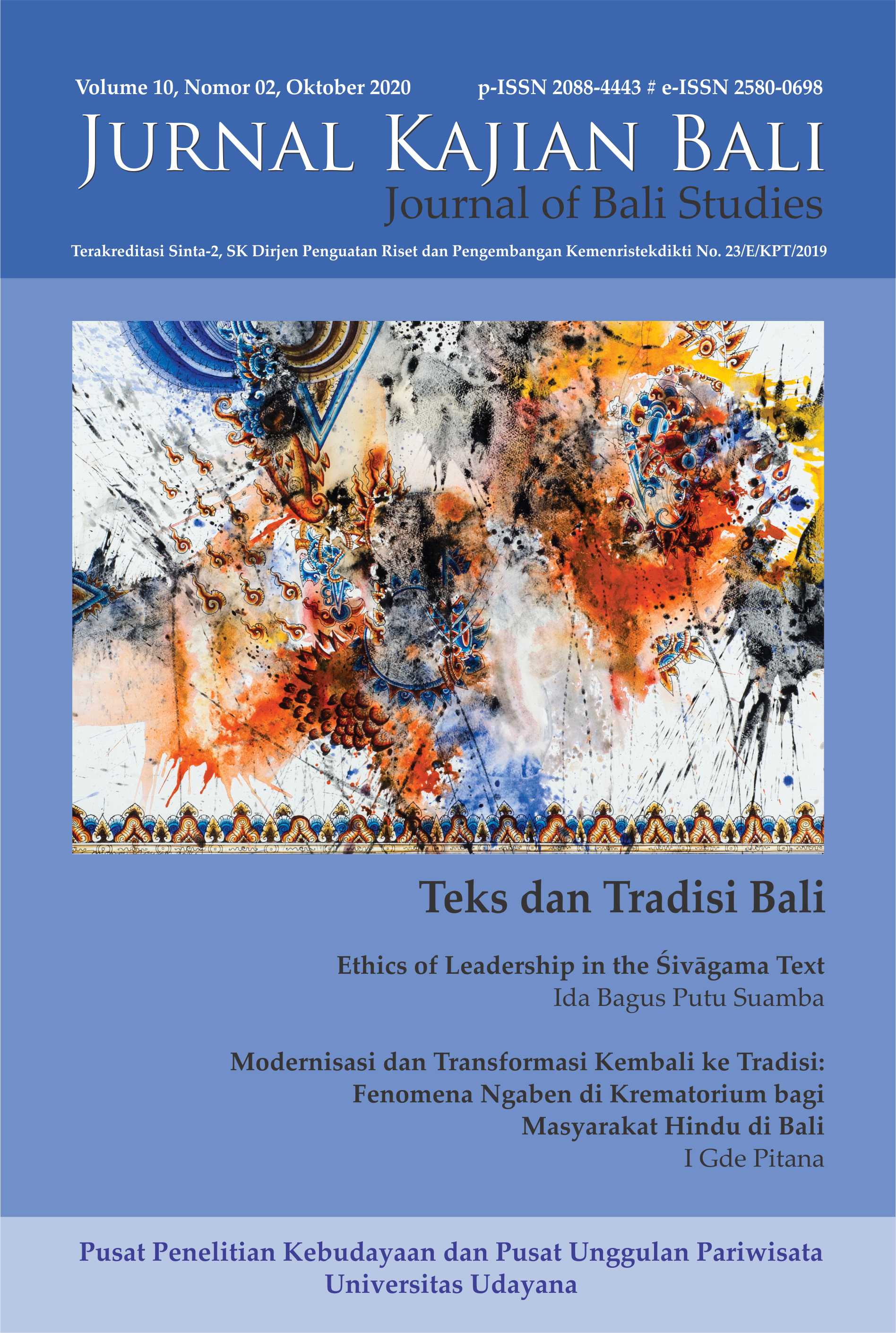Ethics of Leadership in Sivagama Text
Abstract
Ethics of leadership has been dominated by western views about ruling a country; hence marginalizing local cultural ethics of leadership in practice. This paper explores the ethics of leadership as contained in the Balinese text ?iv?gama composed by Ida Pedanda Madé Sidêmên (1858–1984) and its relevance for the modern era. Data was taken from lontar palm-leaf manuscripts and analyzed in a qualitative way focusing on the conception of nava natya (nine ethical principles) of leadership. Also included was the pañca visaya, five external objects and the corresponding senses, which can cause harm when facing enemies. In the past, these ethical principles were used as the basis upon which the royal system of governance was practiced for the welfare of all. This concept is still relevant nowadays as long as service is considered to be a human virtue. The research results thus offer a contribution to the study of leadership ethics in the Old Javanese tradition.
Downloads
References
Agastia, I.B.G. (1994). Ida Pedanda Made Sidemen Pengarang Besar Bali Abad ke-20. Denpasar: Yayasan Dharma Sastra.
Agastia, I.B.G. (2006a). Cokorda Mantuk Ring Rana: Pemimpin Yang Nyastra. Denpasar: Yayasan Dharma Sastra.
Agastia, I.B.G. (2006b). Tri Tantri di dalam Kesusastraan Bali. Denpasar: Yayasan Dharma Sastra.
Agastia, I.B.G. (2012). Pertemuan Ida Pedanda Made Sidemen dan Cokorda Mantuk ring Rana. Denpasar: Yayasan Dharma Sastra.
Agastia, I.B.G. (2013). Kakawin Ramayana dan Tutur Wibhisana. Denpasar: Yayasan Dharma Sastra.
Ardhana, I.K. (2014). “The Dynamics of the Balinese Literature in the Present Day Bali”, Jurnal Kajian Bali, Volume 4, No. 1, pp.31-54.
Fox, R. and A. Hornbacher. (2016). The Materiality and Efficacy of Balinese Letters. Leiden: Brill.
Ginarsa, I.K., I.W. Selamet, and N.N. Putrini. (1985). Siwagama oleh Ida Pedanda Made Sidemen (transliterasi). Jakarta: Departemen Pendidikan dan Kebudayaan.
Gunawan, A. (2015). “Nipah or gebang? A philological and codicological study based on sources from West Java”. Bijdragen tot de Taal-, Land- enVolkenkunde 171, 249-280.
Hinzler, HIR. (1993). “Balinese palm-leaf manuscripts”, Bijdragen tot de Taal-, Land- enVolkenkunde, Manuscripts of Indonesia 149 (1993), no: 3, Leiden, pp. 438-473, http://www.kitlv-journals.nl.
Lestawi, I N., (2018). “The Teaching of “Jñana Sandi” in the Text “Tutur Muladara”, Jurnal Kajian Bali, Volume 08, Nomor 02, Oktober 2018, pp. 15-32.
Mulraj, J. (ed). (2005). Kautilya’s Arthashastra: Its Contemporary Relevance. Pune: Indian Merchant’s Chambers and Indian Merchants’ Chamber Economic Research and Training Foundation and Ameya Prakashan.
Radhakrishnan, S., et al. (eds.) (1962). The Cultural Heritage of India. (Vol. II). Calcutta: The Ramakrishna Mission Institute of Culture.
Robson, S. (1972). “The Kawi Classic in Bali”. Bijdragen tot de Taal-, Land- en Volkenkunde 128 (1972), no: 2/3, Leiden, pp. 308-329. http://www.kitlv-journals.nl.
Rubinstein, R. (1996). ”Colophons as a Tool for Mapping the Literary History of Bali: Ida Pedanda Made Sidemen-Poet, Author and Scibe,” Archipel 52, Paris, pp. 173-191.
Rubinstein, R. (2000). Beyond the Realm of the Senses. Leiden: KITLV Press.
Satyavrat, U. (2001). “Astabrata tradition of Indonesia: Its Sanskrit connection”, Prapandvidya, et.al. (eds.). Sanskrit in South East Asia: The Harmonizing Factor of Culture (Proceedings of the International Sanskrit Conference). Bangkok: Sanskrit Studies Center, Silpakorn University.
Sedyawati, E., I. K. Wiryamartana, S.D. Damono, and S. S. Adiwimarta (eds.). (2001). Sastra Jawa: Suatu Tinjauan Umum. Jakarta: Balai Pustaka.
Shadeg, N. (2007). Balinese-English Dictionary. Singapore: Turtle Publishing.
Suamba, IBP. (2016a). “Nawa Natya sebagai ajaran kepemimpinan: Membaca teks Siwagama karya Ida Pedanda Made Sidemen” (paper) presented in the 6th Parum Param organized by the Culture Office of local Government of Denpasar, 19th September 2016 in Bali Hotel, Denpasar, Bali.
Suamba, I.B.P. (2016b). “’Memahami ‘Karang Awak’ Ida Pedanda Made Sidemen”(paper) presented in Rembug Sastra Purnama Badrawada, 19th June 2016 at Pura Jagatnatha Denpasar, Bali.
Suamba, I.B.P. (2016c). Biografi Ida Pedanda Made Sidemen, Pengarang-Pendeta Bali. Denpasar: Dinas Kebudayaan Pemerintah Kota Denpasar in cooperation with Program Pasca Sarjana Universitas Hindu Indonesia.
Suarka, I. N. (2005). Kajian Naskah Lontar Siwagama, Vol. 2. Denpasar: Dinas Kebudayaan Provinsi Bali.
Sudharta, T.R. (1993). Asta Brata dalam Pembangunan. Denpasar: Upada Sastra.
Weda Kusuma, I.N. (2006). Naskah-naskah karya I Gusti Ngurah Made Agung Pemimpin Perang Puputan Badung Tahun 1906: Transliterasi dan Terjemahan. Denpasar: Pemerintah Kota Denpasar.

This work is licensed under a Creative Commons Attribution 4.0 International License.



















